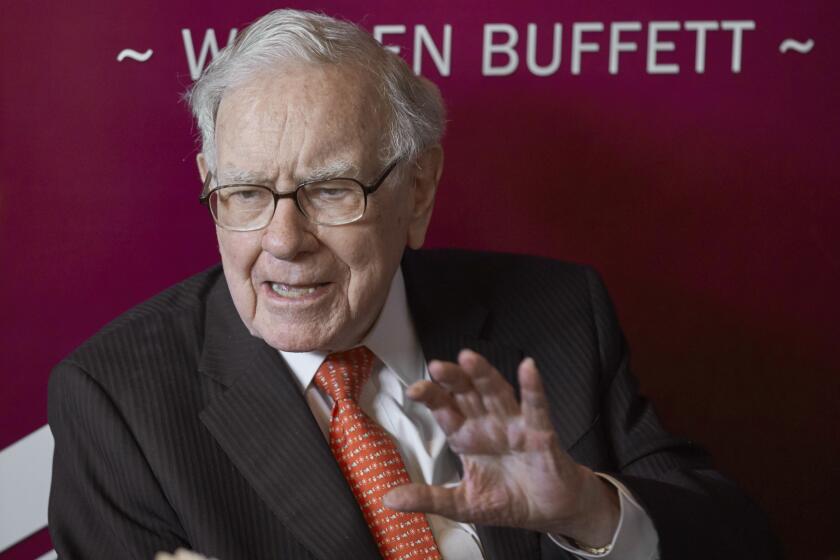New Year Brings a Deluge of Cash to Stock Funds
- Share via
The new year has apparently brought the hoped-for surge in stock mutual fund cash inflows--which may be why the stock market is so far ignoring rising bond yields.
An informal survey of major fund companies shows heavy buying activity by individual investors since Jan. 1, after a weak December.
Vanguard Group in Valley Forge, Pa., for example, says its telephone call volume so far this year--mostly representing investors’ expressions of interest in making purchases, or exchanges among funds--has surpassed the record level of activity in the first few days of 1996.
The Invesco funds group in Denver says its net cash inflow of $128 million since Jan. 1 is double the pace of the same period a year ago. The John Hancock funds group in Boston says purchase activity has been running “above average.” And T. Rowe Price Associates in Baltimore has taken in $200 million into stock funds since Jan. 1, a “fast start” for 1997, according to a spokesman.
January is supposed to be a big month for stock funds. Many investors know to delay purchases in November and December, when funds make annual capital gains payments (buying just before such a payment means an immediate tax liability). So January benefits partly from pent-up demand.
In addition, many companies contribute to employee retirement plans at the start of the year. And many individuals who get year-end bonuses naturally invest some of those dollars in January.
In January 1996, the net inflow into stock mutual funds was a gigantic $28.9 billion--the highest monthly total ever. Can the funds top that this month? If fund managers are assuming a lot more cash is on the way, they may be buying stocks heavily now--one explanation for the stock market’s fresh record highs. But Charles Biderman, a Santa Rosa, Calif., analyst who tracks fund inflows, says his data so far point to a strong January but not a record. That could be problematic for the cash-hungry bull market, with fund managers’ cash reserves already at 20-year lows.
*
Bond Fund Sweepstakes: The official results are in for bond mutual fund performance in 1996, and it was--well, it was a yawner of a year for bonds, frankly. The average bond fund posted a total return of 4.69% for the year, according to fund-tracker Lipper Analytical in New York. That is far below the 1996 gain of 19.5% for the average general U.S. stock fund. It’s even less than the 4.8% earned in the average money market fund.
Moreover, that 4.69% total return means the average bond fund owner actually lost principal value in 1996. Total return is interest earnings plus or minus any change in principal value. With the interest yield on most funds in the 5% to 7% range, a 4.69% return means the typical fund’s principal was eroded a bit--a casualty of the net rise in U.S. market interest rates during the year.
Of course, averages are just that. Some bond funds performed far better than others last year. Many investors were in a “reach for yield,” meaning that if they had to own bonds, they wanted high-risk, high-yielding ones. Thus, emerging-market country bond funds performed best as a category (average total return: a stunning 40.7%), followed by U.S. corporate junk-bond funds (13.7%) and global bond funds (10.4%).
So far this year, with market interest rates on the rise, most bond fund owners are again losing money, while the seemingly impervious stock market is hitting new highs. No wonder bond fund assets of $890 billion pale compared with the $1.76 trillion in stock funds. And no wonder new purchases of bond funds are a pittance compared with what people shovel into stock funds.
Yes, bonds are boring. What could change that? A big drop in interest rates--or, even better, a gruesome stock bear market that would make “boring” investments much more appreciated.
(BEGIN TEXT OF INFOBOX / INFOGRAPHIC)
How Bond Funds Fared
Here are average total returns for key categories of bond mutual funds for three periods ended Dec. 31. Total return includes interest earnings plus or minus any change in the bonds’ principal value.
*--*
Average total return Fund category 4th qtr. 1996 5 yrs. Emerging-markets +8.35% +40.7% NA Global, long-term +3.98 +10.4 +39.1% Junk corporate +3.59 +13.7 +77.4 Mixed +3.57% +6.1% +51.7% Lower-quality corporate, long-term +3.46% +3.2% +49.0% High-quality corporate, long-term +3.11% +2.5% +38.8% U.S. govt., long-term +2.86% +1.7% +33.3% GNMA +2.81% +3.8% +34.3% High-quality corporate, 5- to 10-year +2.79% +3.1% +37.2% U.S. govt. 5- to 10-year +2.60% +2.7% +31.8% Calif. muni, long-term +2.49% +3.7% +39.1% General muni, long-term +2.40% +3.3% +38.9% High-quality corporate, 1- to 5-year +1.84% +4.7% +30.0% U.S. govt., 1- to 5-year +1.77% +4.3% +26.0% Adjustable rate mortgage +1.71% +5.4% +19.0% Money market +1.19% +4.8% +21.4%
*--*
NA: Not available
Source: Lipper Analytical Services Inc.
More to Read
Inside the business of entertainment
The Wide Shot brings you news, analysis and insights on everything from streaming wars to production — and what it all means for the future.
You may occasionally receive promotional content from the Los Angeles Times.










